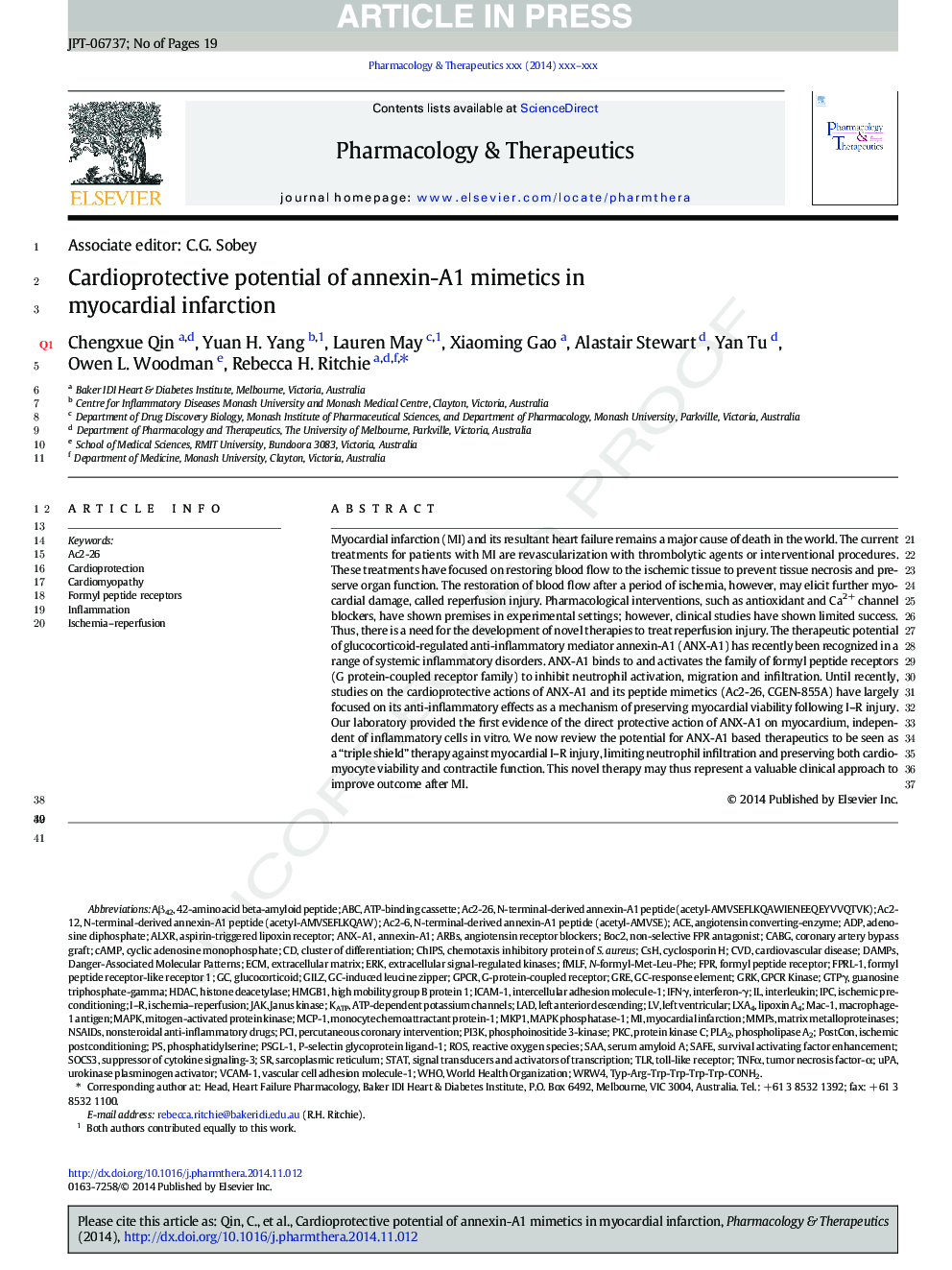| Article ID | Journal | Published Year | Pages | File Type |
|---|---|---|---|---|
| 5843973 | Pharmacology & Therapeutics | 2015 | 19 Pages |
Abstract
Myocardial infarction (MI) and its resultant heart failure remains a major cause of death in the world. The current treatments for patients with MI are revascularization with thrombolytic agents or interventional procedures. These treatments have focused on restoring blood flow to the ischemic tissue to prevent tissue necrosis and preserve organ function. The restoration of blood flow after a period of ischemia, however, may elicit further myocardial damage, called reperfusion injury. Pharmacological interventions, such as antioxidant and Ca2+ channel blockers, have shown premises in experimental settings; however, clinical studies have shown limited success. Thus, there is a need for the development of novel therapies to treat reperfusion injury. The therapeutic potential of glucocorticoid-regulated anti-inflammatory mediator annexin-A1 (ANX-A1) has recently been recognized in a range of systemic inflammatory disorders. ANX-A1 binds to and activates the family of formyl peptide receptors (G protein-coupled receptor family) to inhibit neutrophil activation, migration and infiltration. Until recently, studies on the cardioprotective actions of ANX-A1 and its peptide mimetics (Ac2-26, CGEN-855A) have largely focused on its anti-inflammatory effects as a mechanism of preserving myocardial viability following I-R injury. Our laboratory provided the first evidence of the direct protective action of ANX-A1 on myocardium, independent of inflammatory cells in vitro. We now review the potential for ANX-A1 based therapeutics to be seen as a “triple shield” therapy against myocardial I-R injury, limiting neutrophil infiltration and preserving both cardiomyocyte viability and contractile function. This novel therapy may thus represent a valuable clinical approach to improve outcome after MI.
Keywords
ECMABCNSAIDSPI3KTNFαMmpsDAMPsACEICAM-1ERKHDACCSHMCP-1GREADPGPCRTLRPKCIPCHMGB1Aβ42FPRKATPGRKSAAPCIPLA2IFNγVCAM-1uPASOCS3PSGL-1FPRL-1GPCR kinaseLXA4ATP-dependent potassium channelsfMLFAnnexin-A1MKP1MAPK phosphatase-1Cyclosporin HJanus kinasecAMPG-protein-coupled receptorMAPKN-Formyl-Met-Leu-Pheischemic preconditioningROSadenosine diphosphateCyclic adenosine monophosphateSTATMacrophage-1 antigenphospholipase A2Myocardial infarctioninflammationdanger-associated molecular patternsischemia–reperfusioninterferon-γinterleukinLeft ventricularcardiovascular diseasetumor necrosis factor-αToll-like receptorreperfusion injury salvage kinaseCABGCardioprotectionRiskcluster of differentiationNonsteroidal anti-inflammatory drugsSarcoplasmic reticulumCVDWorld Health Organizationserum amyloid Asuppressor of cytokine signaling-3Phosphatidylserinephosphoinositide 3-kinaseurokinase plasminogen activatorLADlipoxin A4P-selectin glycoprotein ligand-1Extracellular matrixsignal transducers and activators of transcriptionMatrix metalloproteinasespercutaneous coronary interventionintercellular adhesion molecule-1vascular cell adhesion molecule-1Mac-1histone deacetylasemonocyte chemoattractant protein-1Protein kinase Cmitogen-activated protein kinaseischemic postconditioningCoronary artery bypass graftleft anterior descendingJAKChipsCardiomyopathyWHOATP-binding cassetteextracellular signal-regulated kinasesGlucocorticoidReactive oxygen speciesFormyl peptide receptorsformyl peptide receptorGilz
Related Topics
Health Sciences
Pharmacology, Toxicology and Pharmaceutical Science
Pharmacology
Authors
Chengxue Qin, Yuan H. Yang, Lauren May, Xiaoming Gao, Alastair G. Stewart, Yan Tu, Owen L. Woodman, Rebecca H. Ritchie,
